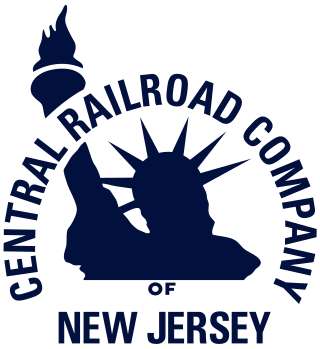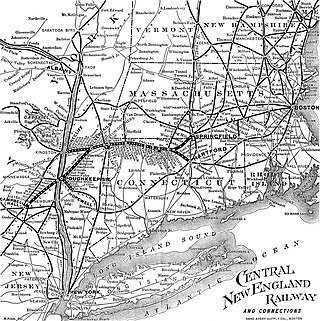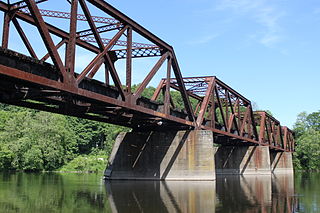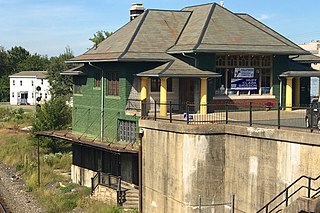
The Delaware, Lackawanna and Western Railroad, also known as the DL&W or Lackawanna Railroad, was a U.S. Class 1 railroad that connected Buffalo, New York, and Hoboken, New Jersey, and by ferry with New York City, a distance of 395 miles (636 km). The railroad was incorporated in Pennsylvania in 1853, and created primarily to provide a means of transport of anthracite coal from the Coal Region in Northeast Pennsylvania to large coal markets in New York City. The railroad gradually expanded both east and west, and eventually linked Buffalo with New York City.
The Lehigh Valley Railroad was a railroad in the Northeastern United States built predominantly to haul anthracite coal from the Coal Region in Northeastern Pennsylvania to major consumer markets in Philadelphia, New York City, and elsewhere.

The Central Railroad of New Jersey, also known as the Jersey Central, Jersey Central Lines or New Jersey Central, was a Class I railroad with origins in the 1830s. It was absorbed into Conrail in April 1976 along with several other prominent bankrupt railroads of the Northeastern United States.

The Central New England Railway was a railroad from Hartford, Connecticut, and Springfield, Massachusetts, west across northern Connecticut and across the Hudson River on the Poughkeepsie Bridge to Maybrook, New York. It was part of the Poughkeepsie Bridge Route, an alliance between railroads for a passenger route from Washington to Boston, and was acquired by the New York, New Haven & Hartford Railroad in 1904. The New Haven ran the CNE as a separate company until finally merging it in 1927. The vast majority of the system was abandoned by the 1930s and 1940s. Surviving portions of the Central New England Railway are operated by the Central New England Railroad and the Housatonic Railroad.

The Delaware and Hudson Railway (D&H) is a railroad that operates in the Northeastern United States. In 1991, after more than 150 years as an independent railroad, the D&H was purchased by the Canadian Pacific Railway (CP). CP, which would itself become part of Canadian Pacific Kansas City in 2023, operated D&H under its subsidiary Soo Line Corporation, which also operates Soo Line Railroad.

The Lehigh and Hudson River Railway (L&HR) was the smallest of the six railroads that were merged into Conrail in 1976. It was a bridge line running northeast–southwest across northwestern New Jersey, connecting the line to the Poughkeepsie Bridge at Maybrook, New York, with Easton, Pennsylvania, where it interchanged with various other companies.
The Morris and Essex Railroad was a railroad across northern New Jersey, later part of the main line of the Delaware, Lackawanna and Western Railroad.

The Warren Railroad was a railroad in Warren County, New Jersey, that served as part of the Delaware, Lackawanna and Western Railroad's mainline from 1856 to 1911.
The Belvidere-Delaware Railroad was a railroad running along the eastern shore of the Delaware River from Trenton, New Jersey north via Phillipsburg, New Jersey to Manunka Chunk, New Jersey. It became an important feeder line for the Lehigh Valley Railroad's join to the Central Railroad of New Jersey, which was constructed into Phillipsburg, New Jersey, at about the same time. This connected Philadelphia and Trenton, New Jersey at one end of the shortline railroad to the rapidly growing lower Wyoming Valley region, and via the Morris Canal or the CNJ, a slow or fast connection to New York City ferries crossing New York Harbor from Jersey City, New Jersey.

The Lackawanna Cut-Off was a rail line built by the Delaware, Lackawanna and Western Railroad (DL&W). Constructed from 1908 to 1911, the line was part of a 396-mile (637 km) main line between Hoboken, New Jersey, and Buffalo, New York. It ran west for 28.45 miles (45.79 km) from Port Morris Junction in Port Morris, New Jersey, near the south end of Lake Hopatcong about 45 miles (72 km) west-northwest of New York City, to Slateford Junction in Slateford, Pennsylvania near the Delaware Water Gap.
North Pennsylvania Railroad was a railroad company which served Philadelphia, Montgomery County, Bucks County and Northampton County in Pennsylvania. It was formed in 1852, and began operation in 1855. The Philadelphia and Reading Railway, predecessor to the Reading Company, leased the North Pennsylvania in 1879. Its tracks were transferred to Conrail and the Southeastern Pennsylvania Transportation Authority (SEPTA) in 1976.

The Lackawanna Old Road was part of the original mainline of the Delaware, Lackawanna & Western Railroad (DL&W). Opened in 1856, it was, for a half-century, a part of the line connecting the states of New Jersey and Pennsylvania.

The Lehigh Gap or Lehigh Water Gap is a water gap located in the townships of Lehigh, Washington, Lower Towamensing, and East Penn in the Lehigh Valley and Coal Region regions of eastern Pennsylvania. It was formed by the Lehigh River, where it cuts through the Blue Mountain in Pennsylvania.

The Blairstown Railway (BRWY) opened in 1877 and ran between Blairstown and Delaware, New Jersey, a distance of approximately 12 miles (19 km). The single-track railroad was built under the direction of railroad magnate John I. Blair, one of the wealthiest persons in the United States at that time, who had previously built the Warren Railroad, and for whom Blairstown is named.

The Lehigh Line is a railroad line in Central New Jersey, Northeastern Pennsylvania, and the Lehigh Valley region of eastern Pennsylvania. It is owned and operated by the Norfolk Southern Railway. The line runs west from the vicinity of the Port of New York and New Jersey in Manville, New Jersey via Conrail's Lehigh Line to the southern end of Wyoming Valley's Coal Region in Lehigh Township, Pennsylvania.

Phillipsburg Union Station is an active railroad station museum, in Phillipsburg, New Jersey, United States, at 178 South Main Street. Opened in 1914, Union Station was built by the Delaware, Lackawanna & Western Railroad (DL&W) and shared with the Central Railroad of New Jersey (CNJ) and was situated where the lines merged before the bridge crossing the Delaware River. Designed by Frank J. Nies, the architect who produced many of DL&W stations now listed state and federal registers of historic places, the 2+1⁄2 story, 3 bay brick building is unusual example of a union station and a representation of early 20th century Prairie style architecture. The Phillipsburg Union Signal Tower, or PU Tower, is nearby, also restored to its original form, and available for tours.
The Panther Creek Railroad had its origins in 1849. The Lehigh Coal & Navigation Company (LC&N) constructed it between Lansford, PA and the Philadelphia & Reading Railroad operating as the Little Schuylkill Railroad in Tamaqua, PA. LC&N believed a direct route to take Panther Valley coal to eastern markets and a tunnel connecting Lansford to Hauto would open up possibilities with the Nesquehoning Valley Railroad. It also allowed the LC&N to cease coal shipments to the Lehigh Canal on the Summit Hill & Mauch Chunk Railroad, operating since 1827.

The Lehigh and Lackawanna Railroad was a railway company in the United States. It was incorporated in 1864 and opened its initial line between Bethlehem, and Chapman, Pennsylvania, in 1867. At its peak, the company's line extended 25.3 miles (40.7 km) from Bethlehem to Wind Gap, Pennsylvania. The company and its line became part of the Lehigh and New England Railroad in 1904. Part of the line was abandoned in 1962; the remainder is part of the Norfolk Southern Railway's Cement Secondary.
















